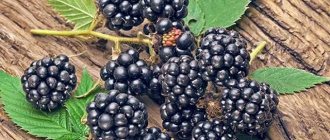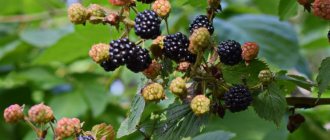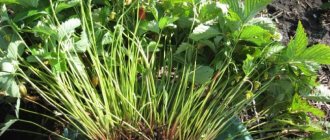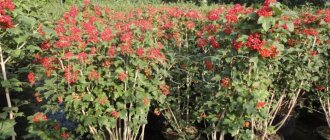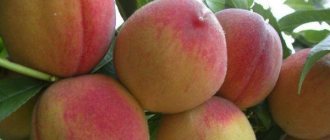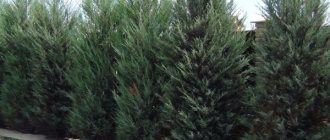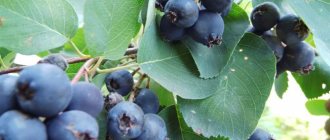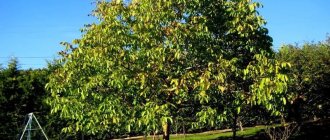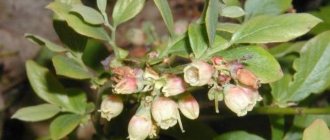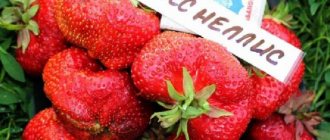General description of varieties of thornless blackberries and photos
The appearance of thornless blackberries is attractive. The lacy plant forms a large bush covered with bright green foliage with a jagged edge. Flowers appear around mid-June. The exact date depends on the variety: early, middle or late. The inflorescences are often white, but there may be a pink or lilac tint. Fruiting lasts from a month or longer, which also depends on the characteristics of the variety. The berries are green at first. When ripe, the fruits first turn red, then turn dark purple or black.
The root system of thornless blackberries is buried up to 1.5 m, which allows the plant to survive drought without reducing yield. The culture is considered two years old. The first year the bush grows fruiting shoots. In the second year they bear berries, and in the fall the fruit-bearing branches are cut off. Replacement shoots are prepared for the next fruiting. In one place, a thornless bush can bear fruit for up to 10 years. Then the plant is transplanted to another place.
Important! Thornless blackberries produce more yield than their thorny relatives. However, the culture is less frost-resistant.
The thornless remontant blackberry is considered an annual plant. The plant bears fruit on the branches of the current year. In autumn, the shoots are cut off at the root. In the spring, new branches grow and immediately begin to bear fruit.
Thornless culture is divided into two types based on the structure of the bush:
- Kumanika is an upright plant with strong, slightly bending branches. The length of the shoots reaches more than 3 m. Kumanika produces a lot of young shoots.
- Dewberry is a creeping plant. Flexible stems stretch more than 6 m long. Dewberry does not sprout young shoots from the roots. An exception may be damage to the root system. A young shoot may emerge from a cut root.
Semi-creeping varieties are less common. In such a crop, strong shoots about 50 cm high grow evenly, then they begin to creep.
Pruning and shaping the bush
In early spring, shoots are pruned: the tops are cut off, which stimulates branching. New side shoots provide new places for flower buds to form and increase the yield of berries. Carry out work with sterile instruments. To do this, wipe it with alcohol or an aqueous solution of bleach. If the shoot is shorter than 60 cm, simply cut off the top 3 cm.
Always remove in the spring any diseased shoots that have dried out or been damaged by rodents or wind over the winter. In blackberries, only shoots of the third year of development bear fruit, so in the summer the branches that bear fruit must be cut off. This stimulates the plant to create new ones.
Advantages and disadvantages of thornless blackberries
To decide to grow a thornless variety, you need to know the advantages and disadvantages of the crop. Let's start with the positive qualities:
- the long fruiting period for most varieties lasts more than two months;
- the thornless plant bears large berries;
- It is easier to pick fruits from a non-thorny bush;
- the plant is unpretentious in care, easily tolerates drought;
- You can pick new ripe berries every two days;
- remontant thornless varieties are easy to care for, since in the fall all branches are cut off at the root;
- thornless varieties are more resistant to diseases.
The disadvantage of thornless varieties is the high cost of seedlings and lower frost resistance.
The best varieties
More than 300 varieties are grown in our country. New crops appear every year. Let's look at the best thornless varieties of blackberries that have proven themselves to be excellent.
Apache
The American thornless variety produces large berries weighing up to 11 g. It is a medium-ripening crop. The bush is erect. The yield reaches 2.4 kg of berries per plant. Fruiting lasts up to 5 weeks.
Arapaho
The early culture, based on the structure of the bush, belongs to the bramble. The berries ripen in July. Fruiting lasts about 4 weeks. The stems grow about 3 m long. The thornless variety can withstand frosts down to –24°C. The berries are large, weighing up to 9 g. Up to 4 kg of fruits are collected from 1 bush.
Black Satin
One of the old thornless varieties of medium ripening brings up to 15 kg of yield per plant. Records were set up to 25 kg with good feeding. The berries are medium-sized, weighing up to 5 g. The structure of the bush is semi-creeping. The variety can withstand frosts down to –22°C.
Important! When grown in cold regions, the plant requires careful shelter for the winter.
Waldo
A productive variety with a creeping bush structure produces up to 17 kg of berries. The fruit weight is about 8 g. The stems grow more than 2 m long. The thornless crop needs good shelter for the winter due to its average frost resistance. Harvest ripening begins in July.
Chief Joseph
The thornless variety has a powerful, fast-growing bush. The length of the stems reaches 4 m. The ripening of berries begins in June. Fruiting lasts 45–50 days. The average weight of the fruit is 15 g, but there are large giants weighing up to 25 g. In the fourth year after planting, the yield of the variety reaches 35 kg per plant.
Doyle
The late-ripening thornless variety is famous for its high yield. You can collect up to seven buckets of berries from a bush. Fruit ripening begins in the second ten days of August. The weight of the berry is about 9 g. The lashes grow up to 6 m long. The plant requires shelter for the winter.
Advice! The variety is suitable for the southern regions and the middle zone. In the northern regions the berries will not have time to ripen.
Columbia Star
The thornless variety has not yet spread much across the expanses of our country. Ripening dates are early. The berries grow large, weighing about 15 g. The structure of the bush is creeping. The length of the shoots reaches 5 m. The variety is suitable for the southern regions, as it can withstand temperatures down to –14°C.
Loch Tay
Thornless variety of medium ripening period. The yield of the plant reaches 12 kg. The weight of one berry is about 5 g. The bush grows stems more than 5 m long. Frost resistance is average. The plant can withstand temperatures down to –20°C. Shelter is required for the winter.
The video provides an overview of the variety:
Loch Ness
The thornless mid-late variety produces up to 25 kg of sweet and sour berries with a forest aroma. The weight of the fruit is about 8 g. The berry ripens in the last days of July. The plant is semi-creeping with a stem length of up to 4 m. Winter hardiness is average. The lashes are covered for the winter.
Important! The main disadvantage of this variety is that it produces sour berries in rainy summers.
Navajo
The late-ripening thornless variety is famous for its good frost resistance. The bush is erect in shape. Fruiting lasts from August to September. Productivity reaches more than 500 fruits per plant. The average weight of one berry is 5 g.
Natchez
The thornless variety will appeal to lovers of early berries. The plant produces up to 20 kg of large fruits, weighing 12 g. Ripening begins in June. Fruiting duration is 1.5 months. The structure of the bush is erect with transition to creeping shoots. The length of the stems reaches 3 m. Winter hardiness is average. For the winter, lashes in cold regions are covered.
The video provides an overview of the variety:
Oregon Thornless
A late-ripening, thornless, creeping variety produces up to 10 kg of berries per plant. Fruit ripening begins in August. The weight of the berry is about 9 g. The thornless stems grow more than 4 m long. Blackberries are considered frost-resistant. The plant can withstand temperatures down to –29°C. When growing in the middle zone, shelter is necessary for the winter.
Osage
Gardeners fell in love with thornless blackberries because of the good taste of the berries. This is the only advantage of the variety. Productivity is low - maximum 3 kg of fruit per plant. The average berry weight is 6 g. Ripening begins in July. The bush is erect, the height of the stems reaches 2 m. Frost resistance is weak. Blackberries can withstand temperatures as low as –13°C.
Ouachita
The thornless early variety pleases with ripe berries in June. An adult bush can produce up to 30 kg of harvest. Fruiting lasts up to two months. The lashes of an erect bush grow up to 3 m long. Winter hardiness is weak. Blackberries can withstand frosts down to –17°C.
Polar
The thornless Polish variety grows without shelter in its homeland. Blackberries can withstand frosts from –25°C to –30°C, but in such conditions a fivefold reduction in yield is observed. Berries ripen later. Fruiting lasts from August to September. The berries are large and can be transported. The erect bush throws out shoots up to 3 m long.
Smutstststem
The old American hybrid is the first-born of thornless varieties. The semi-creeping bush grows lashes 3 m long. The weight of the berries varies from 5 to 10 g. The yield of blackberries reaches 25 kg per plant. Frost resistance is average.
Hull Tornless
The American thornless blackberry hybrid was bred for warm regions, where winter frosts reach a maximum of -8°C. The yield reaches 40 kg of large berries per plant. Semi-creeping bush. The length of the lashes reaches 5 m.
Chačanska Bestrna
The variety is considered early ripening, as the berries begin to ripen in early July. Blackberry yield reaches 15 kg per plant. The weight of the fruit is about 14 g. The thornless plant has a semi-creeping bush shape. The length of the shoots is 3.5 m. Blackberries have good winter hardiness. The plant can withstand –26°C, but is covered for the winter.
Cherokee
The variety is considered thornless, despite the rare presence of almost imperceptible thorns. The yield is 15 kg per plant. The average berry weight is 8 g. The bush is spreading and has a decorative structure. Frost resistance is average.
Chester
A late-ripening, thornless old variety produces a harvest of tasty berries of up to 20 kg per plant. The average weight of one fruit is 8 g. Ripening begins in early August, sometimes at the end of July. A semi-cresting plant grows stems up to 3 m long. Blackberries can withstand frosts down to –26°C.
Varieties
Many cultivated varieties of blackberries have been created in the world for commercial and amateur gardening. One of the largest groups is hybrids of blackberries and raspberries. They were developed under the USDA breeding program. Main varieties: Marion, Chehalem, Olali. They are characterized by original taste and high productivity. Fruiting of most varieties begins in July and lasts until August. Their average yield is about 10 t/ha.
Thornless varieties form the same bush as raspberries. They are very vigorous and require a trellis for support. This group includes: Black Atlas, Chester Thornless, Hull Thornless, Loch Ness, Navajo and many others. Breeders from many countries are working on developments in this direction.
Remontant varieties of thornless blackberries
The difference between remontant blackberry varieties is the appearance of berries on the shoots of the current year. Gardeners have learned to get two harvests from a crop, which depends on the pruning method:
- To get one harvest, in the fall all branches of remontant blackberries are cut off at the root. In spring, new fruiting shoots grow.
- To obtain two harvests in the fall, only old fruit-bearing shoots are cut out. Young blackberry shoots are bent to the ground and covered. Berries on these branches will appear at the end of July. After harvesting, the vines are cut out and new fruits will appear on the stems of the current year in August.
Remontant blackberry varieties are more suitable for the southern regions. In the northern regions, the berries do not have time to ripen.
A prominent representative of the remontant group is the thornless blackberry Freedom. The bush can withstand frosts down to –14°C. The yield reaches 7 kg per plant. Berry weight is about 9 g.
The thornless remontant variety Traveler brings up to 3 kg of yield per bush. Late fruiting begins on August 17. The erect bush bears fruit weighing 8 g.
New varieties of blackberries without thorns - what to expect from breeders
Breeders are constantly developing new varieties of thornless blackberries. In 1998, the Polish Orcan culture was registered. The late-ripening variety bears large berries in August. The bush does not sprout root shoots. In Europe, blackberries are covered with light material for the winter.
Another new product is the thornless blackberry Ruczai. Polish breeders have developed a high-yielding, vigorous shrub that does not sprout roots. Medium-sized berries begin to ripen in the second decade of August.
Features of growing in the Moscow region
The Moscow region belongs to the 4th winter hardiness zone with winter temperatures down to -35°C. For blackberry bushes, these are too low temperatures. You can grow berries if you plant frost-resistant varieties.
The thornless variety Doyle tolerates low temperatures well and is suitable for growing in the Moscow region. Another suitable variety is Illini Hardy. It is considered the most winter-hardy of all. The following 2 varieties also show good resistance to frost, although they are intended for zone 5 - these are Prime Jim and Prime Yang. For successful fruiting, they must be covered with mulch for the winter.
With proper care, blackberries have a long lifespan and fruiting life. Its bushes can bear fruit regularly and are easy to care for. If you have free space, you should consider planting these wonderful shrubs with healthy fruits in your dacha.
Rules for choosing a suitable thornless blackberry variety
To grow thornless blackberries on your plot, you need to choose the right variety. First of all, frost resistance and ripening time are taken into account. These factors determine whether blackberries are suitable for the climatic conditions of the region.
After choosing a suitable group, you can already look at the yield, berry size, bush structure and other characteristics of the variety.
Blackberry varieties without thorns for the Moscow region
It is better to grow varieties adapted to local weather conditions in the Moscow region. Regardless of frost resistance, blackberries will have to be covered for the winter. The plant is at risk from snowless winters, and such winters are observed in the Moscow region. From the list of varieties considered, you can grow thornless Apache and Black Satin blackberries in cold areas.
The thornless blackberry Thornfree has proven itself well in the Moscow region. Dewberry bears fruits weighing 7 g. The bushes are vigorous with vines up to 5 m long.
Blackberry varieties without thorns for central Russia
There are also adapted varieties for growing in the middle zone. A prominent representative is the thornless blackberry Doyle. The crop produces large berries weighing 7 g. The plant easily tolerates cold and drought, but abundant watering increases yield.
The thornless blackberry variety Ruben has taken root well in the middle zone. The remontant crop has a compact bush up to 2 m high. The ripening of berries lasts from August to September. Fruit weight is about 10 g.
Thornless blackberry varieties for the Urals
To successfully grow thornless blackberries in the Urals, they choose not only frost-resistant varieties, but also those that can withstand temperature changes in early spring. The thornless crops of Loch Ness, Black Satin, and Waldo have adapted well.
Polar is considered the best variety for the Urals. Thornless blackberries bear ripe berries in the third decade of June. The yield reaches 5 kg per bush. The plant can withstand frosts down to –30°C.
Blackberries without thorns: planting and care
The agricultural technology used for thornless blackberries is the same as for their thorny relative. In the second year after planting the seedling, it is recommended to pluck all the inflorescences from the fruit branches to allow the root system to grow.
Recommended timing
In cold regions, spring planting of thornless blackberries is preferred, falling in April - early May. In the south, the seedling will have time to take root before winter when planted in the fall. Planting is usually done in September.
Choosing a suitable location
For thornless blackberries, choose a bright area well illuminated by the sun. It is important to protect the plant from winds, strong gusts of which are often observed in the Moscow region. It is optimal to plant bushes along the fence, retreating at least 1 m.
Soil preparation
The bed for planting thornless blackberries is dug up to a depth of 50 cm, and humus or compost is added. Additionally, before planting the seedlings, add a bucket of humus mixed with fertile soil, potassium fertilizer and superphosphate - 25 g into each hole.
Selection and preparation of seedlings
When purchasing, select seedlings with a developed root system, two twigs, and live buds. Before planting, the plant is immersed with its roots in warm water. The procedure accelerates the growth of root shoots.
Algorithm and landing scheme
The optimal planting depth for blackberry seedlings is 50 cm. Water the hole with a fertile mixture of soil and humus. After planting the seedling, another watering is performed, after which the soil is mulched. The above-ground part is shortened, leaving twigs 30 cm high.
The planting pattern depends on the variety of thornless blackberry. Between compact bushes a distance of up to 1.5 m is maintained. For creeping, vigorously growing varieties, a gap of at least 1.8 m is maintained between plants. The row spacing is from 2 to 3 m.
Features of care
Blackberries are an unpretentious plant, but require some attention. It is imperative to pay attention to correct and timely pruning, watering, fertilizing and protection from pests. If planting and care are carried out according to all the rules, the yield from each bush will increase.
Trimming
You need to know that berries appear on last year's shoots. Over the summer, new branches grow that will bear fruit next season. The branches of many varieties reach 4-5 meters, so for growing it is necessary to prepare trellises.
The posts are placed at a distance of 2-3 meters from each other. A wire is stretched between them, at intervals of 30-40 centimeters.
There are several immutable pruning rules that must be followed:
- In the spring, sanitary cleaning of the bushes is carried out. It is necessary to remove frozen and dried shoots. Branches with frozen tops are cut back to the living area. Young plants also need to be cleaned. Pruning must be done before the bushes come to life and begin to bud.
- Young first-year bushes are cleaned twice: in spring and in July. The first time the side shoots are shortened by 5-7 centimeters. In summer, branches that have grown more than half a meter are pruned. It is necessary to remove up to 10 centimeters. If you pinch the tops, the shoots will be stronger. Lateral shoots from young bushes should also be removed, leaving no more than 6-8 pieces.
- On large plants for more than 2 years, all damaged branches are cut off in the spring. There should be 4-10 shoots left in the bush. The lateral shoots should contain up to 8 buds, the rest can be cut off. During the summer it is necessary to remove root lashes. At the same time, spring branches cannot be touched; they will bear fruit next season. Shoots that have already borne fruit must be checked. Weak and damaged ones must be removed.
Pruning is an important step in caring for blackberry bushes. If this is not done, the yield will drop sharply.
Watering
Watering mature plants is often not recommended. It is enough to thoroughly moisturize 3 times a season. It is necessary to water the bushes at the end of the flowering period and fruit formation. The last deep moistening is carried out after harvesting. At the same time, it is necessary to loosen the soil to a depth of 5-10 centimeters. Before wintering, it is necessary to apply organic fertilizers to the tree trunk circle in a layer of 5-10 cm.
After all the autumn procedures, the blackberries are removed from the trellises, placed between the rows and sprinkled with earth. The top of the bushes can be covered with leaves, sawdust, and straw.
Film is not the best insulation for blackberries. If winters are very frosty, then you can use wood panels, agrofibre
Caring for thornless blackberries in spring, summer and autumn
To get a good harvest, thornless blackberries need care throughout the growing season.
Principles of growing thornless blackberries
All thornless blackberries, regardless of the growth of the bush, need to be tied to a support. It is optimal to install trellises made of posts and wire. To increase productivity, fertilize, form a bush, loosen and mulch the soil. In the fall, be sure to add superphosphate and ash to the soil. In the spring, feed the bushes with compost and ammonium nitrate.
Installation diagram of a trellis made of poles and wire
To install the trellis you will need wooden or metal support posts, as well as wire and eye screws. It is not necessary to paint the wood, but painting will extend the life of the trellis. The support pillars are dug into the ground to a depth of 0.5 m, and then wire is pulled over them. The bottom row is at a height of 0.4 m. It is secured with screws. The shoots are tied with soft strips of fabric so as not to squeeze them.
Use wire with a diameter of 2 mm or thicker. A thinner one will sag and the trellis will look sloppy.
Necessary activities
Mandatory measures for caring for thornless blackberries include the following:
- In the fall, blackberries are provided with shelter, which is removed in the spring immediately after the snow melts.
- The soil around the bushes is kept clear of weeds, loosened after each watering, and mulched to retain moisture.
- Watering is carried out once a week, and then while pouring berries. Long roots themselves extract moisture from the depths of the earth. Spring and autumn watering is required to recharge the bush.
- Fertilizing cannot be done with fresh organic matter. Rotted manure works well. In the spring, nitrogen-containing fertilizers are applied to stimulate the growth of the bush. 20 g of ammonium nitrate per 1 m2 of bed is suitable. Phosphorus is added during fruiting, and potassium is added closer to autumn.
Pests rarely visit blackberries, but when they appear, the plantations are sprayed with chemicals.
Pruning thornless blackberries in spring
Pruning in the spring is done only for sanitary purposes. Old fruit-bearing shoots are removed if they were not cut out in the fall. Additionally, all frozen and budless branches are pruned. When pruning, do not leave stumps to prevent pests. Remontant thornless varieties are not pruned in the spring, since all branches are cut off at the root in the fall.
More details about pruning thornless blackberries are shown in the video:
Preparing for winter
After autumn pruning, thornless blackberries in cold regions are prepared for wintering. The lashes are removed from the trellises, tied with twine, and pinned to the ground with wire. Upright bushes have fragile shoots. To prevent them from breaking, weights are tied to the tops in the fall. Under the weight of the blackberry branches, they bend to the ground, and they can easily be covered.
Spruce branches are ideal for insulating thornless blackberry bushes. The spines prevent rodents from getting in. You can use non-woven material paired with film.
The video shows how to properly cover blackberries:
Landing algorithm
Most often, seedlings are grown in a greenhouse before purchase, which means that they may be too tender for planting in open ground. For such plants, it is better to plant after the threat of spring frost has passed.
It is also recommended to carry out acclimatization. To do this, the bush is taken outside for a while during the week before planting. Hardened plants are better accepted and develop after planting in a permanent place. For planting you will need: a seedling, organic fertilizer in the amount of 0.5–1 bucket, sand if you need to make the soil looser.
Planting blackberries step by step:
- Dig planting holes at a distance of at least 1 m from each other. The shrub will need such a long distance when it begins to develop.
- Carefully remove the plant from the pot and straighten the roots.
- Prepare the soil mixture: mixing soil, organic fertilizers in equal parts and adding sand up to 30%.
- Place the seedling in the hole and fill it with soil around the roots. The plant should be installed at the same depth as it was growing in the pot.
- Make sure that the growth bud is no deeper than 3 cm from the soil surface.
- Compact the soil at the roots.
- Water the bush thoroughly.
Video: Planting blackberries
Propagation of thornless blackberries
You can propagate thornless blackberries yourself in the following ways:
- Seeds. A complex method that does not preserve the varietal characteristics of the crop. The seeds do not germinate well.
- By layering. In August, the scourge is bent to the ground and covered with soil, leaving only the top. The following spring, the plants are cut off from the mother bush and planted.
- By cuttings. Branches 15–20 cm long from woody shoots germinate best in damp soil. You can cut green cuttings from the tops, but the planting will have to be covered with a greenhouse.
- Air layering. The grafting site is wrapped with a piece of film filled with soil. The soil is constantly wetted from a syringe with a needle. In a month, a cutting with a root will appear, which can be separated.
Thornless blackberries are not propagated by offspring, as these varieties do not produce young shoots. The option of dividing the bush or using root cuttings is possible, but the process requires care and is difficult for novice gardeners.
Transplantation process
Thornless blackberries require periodic replanting, since layering of the tops and root cuttings produce new shoots that can turn into impenetrable thickets. It will be inconvenient to harvest from them. There are other ways to propagate blackberries - by seeds. This technique is used mainly by professionals for breeding new varieties.
Digging up roots for replanting by division is best done after the fruiting process has ended and before flowering begins. No need to wait for frost. It is better to replant until the earth cools down. This will prevent many blackberry diseases and allow you to get a high-quality harvest for the next season.
You should dig out the bushes carefully, going deep enough into the ground so as not to damage the roots of the plant. It is best to use a technique for this that involves the formation of solid earthen lumps. Shoots that are fragile should be separated without the help of tools, that is, by hand.
Thornless blackberries also need to be prepared correctly for winter. The process is practically no different from caring for other plants. Frost-resistant varieties do not need to use mulch at all.

